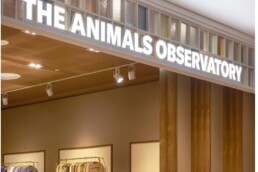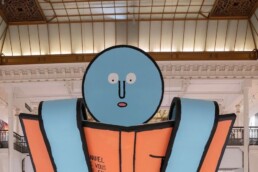Mouse in the House captured our interest at Playtime New York with a wonderful earthy toned knitwear collection. So how do you create this muted colour palette? Natural Plant Dye, a process that has been in practise since ancient times, with the earliest written record of the use of natural dyes dating back to 2600 BC in China. Mouse in the House let us look at the dyeing process of their producers in Nepal and we discover more about this interesting process of making natural plant dye knitwear.
Most of the dyes for their collection are sustainably sourced from the forests that surround the village where their knitters live, in Nepal. A few have to be ordered from India, but their Nepalease makers are quite resourceful and careful with what they have available locally.

Natural dyes can be sorted into three categories: natural dyes obtained from plants (indigo), those obtained from animals (cochineal), and those obtained from minerals (ocher). Although some fabrics such as silk and wool can be colored simply by being dipped in the dye, others such as cotton, require a mordant. In Mouse in the House’s case they focus on using natural plant dyes.
A mordant is an element which aids the chemical reaction that takes place between the dye and the fiber so that the dye is absorbed. Containers used for dying must be non-reactive (enamel, stainless steel.) Brass, copper or iron pots will do their own mordanting. Not all dyes need mordants to help them adhere to fabric. If they don’t require mordants, such as lichens and walnut hulls, they are called substantive dyes. If they do need a mordant, they are called adjective dyes.
Common mordants are:
- ALUM, usually used with cream of tartar, which helps evenness and brightens slightly.
- IRON, which saddens or darken colors, bringing out green shades.
- TIN, usually used with cream of tartar, which blooms or brightens colors, especially reds, oranges and yellows.
- BLUE VITRIOL, which saddens colors and brings out greens.
- TANNIC ACID, used for tans and browns.
Madder is used by Mouse in the House for Aw17 and is a good example of a commonly used natural plant dye. It is obtained from the madder plant and produces a red colour. To collect the Madder, the plants are dug up, the roots washed and dried and then ground into powder. The dye was popular during the 19th century, then in the mid-1800s a synthetic substitute was developed which is commercially used now. This video shows the madder root used for dyeing the pink color called “Sunrise” used in their collections.
[KGVID]https://pirouetteblog.com//wp-content/uploads/2017/04/IMG_2444.mov[/KGVID]
Mouse in the House produce their collection in Nepal working with a group of talented nepalese makers who earn a living wage significantly higher than other fair-trade organisations. It’s obvious that they deeply value the importance of seeking out high quality, sustainable, natural materials that are produced in ethical ways with respect to humans and the planet.
Their Products:
- Hand-dyed yarn using sustainably-sourced plant dyes.
- Pure australian merino wool, hand-plied yarn.
- Wooden buttons locally made from Allo – a giant nettle that grows wild in nepal’s mountains.
- Hand-felted, undyed felted wool balls.
We have also seen vegetable and plant dying used by the label UPA for their SS17 collection but in their case using silk. The process is fascinating with all the possible variations and tones of colour that can be produced. The makers in Nepal certainly know their craft in great depth, and in turn the modest modernity that Mouse in the House injects to the collection with their general ethos towards producing children’s clothing makes for a very wonderful collection for AW17.






Mouse in the House
Mouse in the house was formed by husband and wife, Scott and Ashley Jensen. They are driven by the belief that children deserve to wear and use items that are beautiful, hard working and created under the best circumstances possible.
Their products are born out of a love of textiles, an obsession with high quality children’s products, and an intense desire to do some good in the world. They are raising their two young daughters surrounded by natural beauty in a rural community near Seattle, Washington.
We bring economic opportunity to underprivileged women in developing nations. By paying an above-average wage, providing job skills development and reinvesting 5% of all sales directly into their communities, we help improve their quality of life, promote self-reliance
Scott and Ashley Jensen
Mithshop.com
Katie Kendrick
Katie is a specialist in kids’ fashion and lifestyle, editor, consultant, content creator, and owner of Pirouette - a leading resource to the industry.
With a keen interest in both the business and creative aspects of the industry Katie has interviewed buyers, agents, stylists, designers, influencers, covered runway shows, produced trade show reports and curates thought provoking and engaging exhibitions.
She is passionate about good design, creativity and brands that manage to combine this with their environmental responsibility.
Subscribe to Pirouette's monthly Newsletter.
You might also like
October 24, 2024
A Day in the Life… Margaux Giudicelli, Loumio
A day in the life of a kids' swimwear brand owner. Looking for new sustainable swimwear to offer your customers. Well check out eco-friendly, stylish, and protective children’s swimwear for a…
October 21, 2024
Shrimps x BINIBAMBA
Pirouette loves a good collaboration.Wrap your little ones up this holiday season with the nostalgia-tinged tones of the Shrimps x BINIBAMBA collection. Capture the cosiness of Christmas with…
August 23, 2024
Another new store opening for The Animals Observatory in South Korea.
A new store opening for The Animals Observatory in South Korea at Daejeon Shinsegae Art & Science:1 Expo -Ro, Yuseong-Gu Daejeon taking the number of store mon-brand stores to 4 in the country.…
February 29, 2024
Jean Jullien’s ‘Paper People’ at Le Bon Marche Rive Gauche, Paris
If you're in Paris make sure to pop into Le Bon Marche, Rive Gauche - there you will encounter two gigantic blue paper people created by Jean Jullien. Art set in a retail space ensuring an enhanced…
October 6, 2021
Pirouette kicks back into action
After being hacked & disabled we're back to bringing the whats what in Kid's fashion & lifestyle! Pirouette has been a little quiet for a while. In part at least because I've been working for…
August 27, 2020
Little Creative Factory AW20 collection ‘Unexpected Poetry’ launches today!
It's been a year since founder and designer of Little Creative Factory made the big move to the even bigger Apple with her lovely family. What a year it has been, there's no stopping this family…
November 12, 2019
Pirouette #CoupDeCoeur: Quiet Town Shower Curtains
The covetable shower curtain is quite the elusive thing to discover, however Brooklyn based Quiet Town's wonderful designs are something a little bit special. Discover Pirouette's #CoupDeCoeur Quiet…
October 21, 2019
Maison Mangostan x Melijoe
Sneaker addicts at the ready! Colourful and covetable footwear label Maison Mangostan and Pirouette favourite kid’s fashion retailer Melijoe have come together to create a very special limited…
September 27, 2019
Photography: The Many Faces of the Grown Man’s Self – Léa Wormsbach
Proving studio shoots need not be boring - a rich deep colour palette can project a luxury aesthetic and stand out from the saturated tendency of standard catalogue shots. The photography of Léa…











